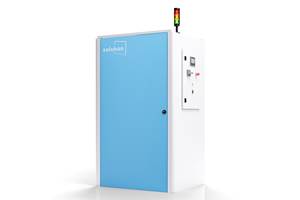Solukon Upgrades SFM-AT350/-E Depowdering System to Handle Larger, Heavier Parts
The SFM-AT350/-E depowdering system can accommodate the increased weight due to an adapted arm design, which means that the chamber volume and the associated inert gas consumption remain the same.
Share
The Solukon SFM-AT350/-E depowdering system can handle parts with dimensions of 400 × 400 × 400 or 500 × 280 × 400 mm. Source: Solukon
Solukon has enhanced its SFM-AT350/-E depowdering system with an adapted arm design that can accommodate parts weighing up to 100 kg as well as the plates of the flagship printers EOS M 400 and Nikon SLM 500.
According to the company, there is a trend in the medium-sized additive manufacturing (AM) part segment in which the total weight of laser powder bed fusion (LPBF) parts has increased. One reason for this is that the parts are usually produced on solid build plates, sometimes with numerous complex support structures. As an immediate downstream process, depowdering must grow along with printing the heavier parts. That is why Solukon has upgraded its SFM-AT350 depowdering system.
In the future, the SFM-AT350 will be able to accommodate parts with a total weight of up to 100 kg and dimensions of 400 × 400 × 400 or 500 × 280 × 400 mm. The SFM-AT350 was originally designed only for parts weighing up to 60 kg and was only compatible with parts measuring a maximum of 350 mm on the X-axis.
The increase in total permitted weight is achieved exclusively through an adapted arm design, which means that the chamber volume and the associated inert gas consumption remain the same. With this upgrade, Solukon has also increased the compatibility of its system.
“Many of our current and potential customers print their medium-sized parts on an M 400 from EOS or a Nikon SLM 500. The upgraded SFM-AT350 is now compatible with both of these printers and therefore covers two more key additive manufacturing systems in this size range,” says Andreas Hartmann, Solukon CEO/CTO.
The new version of the SFM-AT350 offers customers with larger, highly complex components (such as in the aerospace or medical sectors), a well suited depowdering system. For parts with larger dimensions and weights higher than 100 kilograms, Solukon’s next larger depowdering system, the SFM-AT800-S, is the more optimal peripheral device.
The SFM-AT350 was launched in October 2021, featuring a compact design in conjunction with a generous freedom of movement and unique digital functions. Utilizing the SPR-Pathfinder software, an optimal motion sequence can be automatically calculated in advance based on the part’s CAD file — no programming is required. The optional Digital-Factory-Tool is a sensor and interface kit that tracks all the key data on the depowdering operation and summarizes it in a protocol file to ensure maximum transparency.
“These smart features have also become a must in the medium-sized part segment since the parts and support structures are becoming more and more complex here too,” Hartmann adds. “We are pleased that we were able to launch two sophisticated digital tools on the market so early with the DFT and SPR-Pathfinder software, and have once again demonstrated our innovative strength.”
The aim of the latest upgrade is to offer users with larger components weighing up to 100 kg a cost-optimized solution without compromising on functionality. “No other system in this segment offers so many equipment options and functionality, and closes an important gap in the growing price pressure in the service sector,” Hartmann says.
Two Available Excitation Options:
- The SFM-AT350 has adjustable pneumatic vibration with the option of adding a knocker.
- The SFM-AT350-E can come with piezoelectric excitation, which cleans parts very gently by using very high, self-regulating ultrasonic vibration.
Related Content
Depowdering Station Automatically Cleans Unused Metal Powder from 3D Printed Build Jobs
The Volkmann additive manufacturing technology is designed to safeguard workers from toxic materials and boost efficiency.
Read MoreAvia Tools' Depowdering Systems for Metal 3D Printed Parts
Aviation manufacturer only landed in the additive manufacturing segment out of necessity in order to address a client’s depowdering issue. Now it has developed a range of system sizes for any 3D printed part up to 1 metric ton and 1.5 m tall.
Read MoreSolukon’s Metal Powder Collection Unit Offers Simple, Safe Material Handling
With the SFM-PCU integrated into the additive manufacturing system, users no longer have direct contact with the powder material during depowdering — the powder remains in a closed system at all times.
Read MoreCollaborators Developing Green Part Processing Solution for Cold Metal Fusion Technology
Formnext 2024: The AutoSmooth project was launched last year to develop a fully automated process chain for unpacking, depowdering and surface treatment of cold metal fusion parts.
Read MoreRead Next
Profilometry-Based Indentation Plastometry (PIP) as an Alternative to Standard Tensile Testing
UK-based Plastometrex offers a benchtop testing device utilizing PIP to quickly and easily analyze the yield strength, tensile strength and uniform elongation of samples and even printed parts. The solution is particularly useful for additive manufacturing.
Read MoreAlquist 3D Looks Toward a Carbon-Sequestering Future with 3D Printed Infrastructure
The Colorado startup aims to reduce the carbon footprint of new buildings, homes and city infrastructure with robotic 3D printing and a specialized geopolymer material.
Read MoreCrushable Lattices: The Lightweight Structures That Will Protect an Interplanetary Payload
NASA uses laser powder bed fusion plus chemical etching to create the lattice forms engineered to keep Mars rocks safe during a crash landing on Earth.
Read More





















